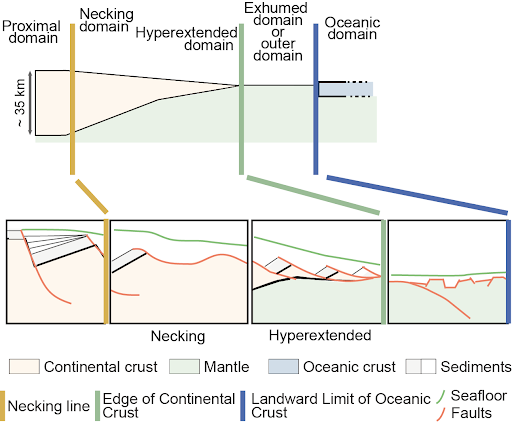
Rifted margins are regions at the transition from oceanic to continental crust, formed by the stretching and thinning of the Earth’s lithosphere before the creation of new ocean basins. The study focused on three key transects across Atlantic rifted margins. In their 2013 article in Marine and Petroleum Geology, Peron-Pinvidic et al. present a comparative analysis of the architecture of various rifted margins. The authors highlight key structural features, tectonic processes, and conceptual models, with the aim to elucidate the geological processes driving their formation and evolution. The three transects are the Iberian-Newfoundland, Norway-East Greenland and Angola-Brazil margins, which are commonly referred to as end-members of magma-poor, magma-rich, and sediment-rich margins, respectively. Despite local variations in various parameters, the study finds that rifted margins evolve towards similar architectures, suggesting that continental lithosphere always responds in similar ways to the constraints imposed by extension.
A central question addressed in the article is whether structural differences in rifted margins are the result of unique processes at each margin or due to local peculiarities of the continental crust. The authors note that, while there are significant local differences, there are mainly first-order similarities, particularly concerning the oceanward transition. Local perturbations in rift development are attributed to inherited crustal discontinuities that can reactivate, variations in the thermal and compositional state of the lithosphere, changes in rock rheology during evolution, and shifts in the velocity of extension.
The study identifies five distinct structural entities, i.e. the proximal, necking, distal, outer and oceanic domains (Fig. 1), which are each associated with a specific phase of rift formation. These phases are not strictly successive and can overprint each other. Notably, the magmatic phase, which is typically late, can also begin early in the rifting history, complicating the understanding of how magmatic events link to necking, segmentation, breakup, and early seafloor spreading.

Fig. 1 Schematic section of typical rifted margins in the Atlantic illustrating the various terms used in Peron-Pinvidic et al.’s contribution (modified after Frasca et al., 2024). The profiles show main structural features, with an explanation of the colors used for main boundaries and type of rocks.
A significant controversy discussed in the article concerns the varying interpretations of seismic imaging data and the resulting conceptual models. While there is general agreement on the broad mechanisms of rift formation, discrepancies in data interpretation lead to differing views on specific processes, such as the extent of magmatic versus tectonic contributions. Questions remain about the parameters controlling magma formation during rifting, its percolation through the lithosphere, and the thermal and subsidence histories of magmatic systems.
Peron-Pinvidic et al.’s review offers a unified conceptual framework for studying rifted margins and highlights several promising research directions. These include the application of geophysical technologies for higher resolution imaging of subsurface structures and the integration of numerical modeling to refine predictions and conceptual models. The article also cites seminal and recent papers that have advanced the understanding of rifted margins, providing a comprehensive bibliography for further exploration. For an updated perspective on the topic, recent review articles either adopt a similar descriptive approach (Peron-Pinvidic et al., 2019; Chenin et al., 2022) or a more process-driven perspective (Brune et al., 2023; Pérez-Gussinyé et al., 2023).
Written by Gianluca Frasca, and the TS Must-Read Team
References
Brune S, Kolawole F, Olive J-A, et al, 2023. Geodynamics of continental rift initiation and evolution. Nature Reviews Earth & Environment 4, 235–253. https://doi.org/10.1038/s43017-023-00391-3
Chenin P, Manatschal G, Ghienne J-F, Chao P, 2022. The syn‐rift tectono‐stratigraphic record of rifted margins (Part II): A new model to break through the proximal/distal interpretation frontier. Basin Research, 34, 489–532. https://doi.org/10.1111/bre.12628
Frasca G, Manatschal G, Chenin P, 2024. Kinematic reconstruction of the Alpine Tethys and surrounding Mesozoic rifted margins. International Journal of Earth Sciences 113, 1053–1065. https://doi.org/10.1007/s00531-024-02407-9
Pérez-Gussinyé M, Collier JS, Armitage JJ, et al. 2023. Towards a process-based understanding of rifted continental margins. Nature Reviews Earth & Environment 4, 166–184. https://doi.org/10.1038/s43017-022-00380-y
Peron-Pinvidic, G., Manatschal, G., Osmundsen, P.T, 2013. Structural comparison of archetypal Atlantic rifted margins: A review of observations and concepts. Marine and Petroleum Geology 43, 21-47. https://doi.org/10.1016/j.marpetgeo.2013.02.002
Peron-Pinvidic, G., Manatschal, G., & “IMAGinING RIFTING” Workshop Participants, 2019. Rifted margins: State of the art and future challenges. Frontiers in Earth Science 7, 218. https://doi.org/10.3389/feart.2019.00218


